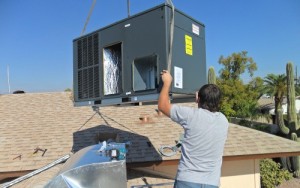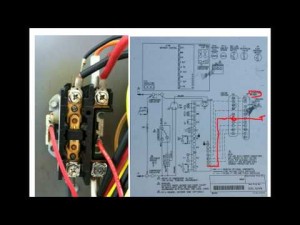Arizona-Based American Cooling and Heating Presents….
Mesa, AZ Air Conditioning and Heat Pump Maintenance Efficiency Guide
A Three-Fold HVAC
MAINTENANCE AND PERFORMANCE CHECKLIST
Herein you will find information concerning:
- Mesa building permits
- HVAC contractor licensing requirements
- Air conditioning and heat pump residential maintenance issues
- The factors most pertinent to effective A/C maintenance
- Methods to help you reduce your Mesa home cooling expenses
- Distinctions in types of cooling system maintenance services
- Responsibilities of the heating and cooling service tech
- Your personal responsibilities as a Mesa homeowner
- A three-fold checklist concerning the typical HVAC tune-up process
- AND More.
As the homeowner, you can perform some of the maintenance processes on your own. However, certain task such as performance tests and airflow measurements normally require the services of a professional Mesa A/C and Heat Pump service company.
Table of Contents
Arizona-Based American Cooling and Heating Presents…. 1
Table of Contents 2
HVAC Contractor Licensing In A/C Maintenance, Upgrades and New Installations 3
Purpose of HVAC Permits and Licenses 3
Mesa HVAC Permit Specifics 3
INTRODUCTION 4
Effective A/C Maintenance Promotes Better Home HVAC Equipment Performance 4
Factors Involved – A/C Maintenance in a Nutshell 4
SCOPE of Content 5
1.0) PURPOSE – Basic A/C and Heat Pump Maintenance Processes 5
2.0) FACTORS – Components of Residential HVAC Maintenance 5
3.0) IMPLEMENTATION – System deficiencies, detect and correct 6
MAINTENANCE AND PERFORMANCE CHECKLIST 8
1.0) Air Distribution Components 8
2.0) Temperature Management 8
3.0) System Freeze Up 8
HVAC Contractor Licensing In A/C Maintenance, Upgrades and New Installations
Whether residing in Washington, DC, Charlotte, NC or Mesa, Arizona, every homeowner eventually encounters the concept of construction permits and/or contractor licensing. The necessities of a building permit change from region to region and with accordance to the scope of a given project. However the importance of always working with a properly licensed HVAC contractor will never change. You should accept air conditioning services only from a bonded, insured and licensed Mesa air conditioning professional.
Purpose of HVAC Permits and Licenses
By nature, a building permit is designed to provide reasonable assurances that a home is safe from structural failure, electrical shock, undue health risks, and fire hazards associated with electrical components and home heating and cooling systems. They also help homeowners and city officials ensure that housing contractors have a valid contractor’s license for services within a specific geographical location and for performing a specific work task within that location. Furthermore, permits and evidence of contractor licensing can be useful during the sale or refinancing of a home. In many regions of the nation, prospective lending institutions require proof that existing alterations to the home were performed in compliance with local codes.
However, not every home improvement or home structural change requires that the homeowner take out a building permit. According to the Mesa-AZ online government resource page, Mesa-related building permits are only required when a structural change or major alternation is performed on an existing building or when any new construction project is undertaken. Each separate process of the construction requires a distinct and separate permit. Examples of processes requiring permits include:
- Electrical Work
- Mechanical Work
- AND Plumbing Work.
Processes that do not require a permit are many, including installing new cabinets, roofing materials, window awnings, and various plumbing activities. However, most of these projects do include exceptions wherein some aspects of such projects may require your contractor to take out a building permit in your behalf.
Mesa HVAC Permit Specifics
When dealing with HVAC equipment in Mesa, no permit is required if your contractor is changing out a unit with a system in the same tonnage. However, permits are required on all new installations. Before signing your contractor make sure you know who will accept the responsibility for obtaining any necessary permits.
INTRODUCTION
Effective A/C Maintenance Promotes Better Home HVAC Equipment Performance
A host of issues affect the cost of home heating and cooling. Adding heavy window drapes, additional attic installation and better sealing the doors are steps that you can use when striving to reduce the cooling load on your home. You can also switch over to more natural cooling processes such as electric fans, open windows, and specialty A/C water cool systems. Simple steps like bumping the thermostat up a few degrees can also reduce the cooling expenses.
System tune-ups and annual scheduled HVAC maintenance helps ensure that your existing equipment is prime-functional for it’s capacity. In older homes with aging air conditioning systems, upgrading to a new energy-efficient heat pump will likely produce a dynamitic decrease in the system’s energy consumption level.
Factors Involved – A/C Maintenance in a Nutshell
All heating and cooling equipment requires a reasonable measure of adjustments, cleaning, monitoring and routine maintenance. To best ensure that your Mesa home air conditioning system endures unto an expected life cycle:
- Make time for habitual inspections
- Schedule yearly and semi-annual A/C system tune-ups
- Make routine maintenance of inside filters and registers your personal task
- Protect your warranty by rigidly following the original equipment manufacturer’s specifications.
To ensure that your system operates at peek performance and to reduce waste due to loss performance issues, learn and practice the following three principles of HVAC service and maintenance:
- The essential HVAC service requirements for maintaining a comfortable and healthy indoor environment
- Service factors that help keep your Mesa home heating and cooling equipment functioning efficiently throughout the expected lifecycle
- AND the specifics of A/C and Heat Pump service and upkeep unique to the residential community of Mesa, Arizona.
SCOPE of Content
This article takes the form of generic guidance. For exacts concerning your Mesa home air-conditioning system, consult your local HVAC service center. However if you do follow the herein included basic A/C performance checklists, you have a much better chance of keeping your equipment on-par, up to specs, and reasonably reliable through the brutal Mesa summers.
This paper also assumes that your Mesa home HVAC equipment was designed, sized and installed according to industry standards, applicable legal codes, and the associated original equipment manufacturers specifications.
1.0) PURPOSE – Basic A/C and Heat Pump Maintenance Processes
Performing regularly scheduled HVAC system assessments, maintenance, and corrective repairs extends component and system efficiency, advances national efforts to ensure healthy clean air, promotes reduced utility expenses, helps reduce the occurrence of unexpected failures, and promotes longer a longer system life cycle. Furthermore, efficient home air conditioning benefits both the environment and the local homeowner.
2.0) FACTORS – Components of Residential HVAC Maintenance
Although all HVAC contractors approach equipment maintenance and service with some degree of customized exceptions, they must all weigh in with a balance between service types and service intensity. Furthermore, they must also strive to operate within the established standards for reasonable A/C and Heat Pump inspection and maintenance requirements.
Factors that affect the approach and processes associated with servicing air conditioning equipment include:
2.1) Type of Service
- Clean and Check
- Seasonal Tune-Up
- Full Maintenance Services
2.2) Condition of Existing Equipment
2.3) Efficiency and Accuracy of the Original System Installation
2.4) Regional Locations
3.0) IMPLEMENTATION – System deficiencies, detect and correct
Whether performing your own maintenance inspection or working with an HVAC contractor, implementation of the inspection seeks to detect system deficiencies that do or can impair the performance of the system. Once deficiencies are discovered, you must define the actions necessary for correcting the revealed problems.
Typically, you work with a appropriately licensed Mesa HVAC contractor. As such, some of the following responsibilities and components of an A/C maintenance inspection fall upon the contractor and some fall upon the homeowner. Thus we assume that your situation falls within the following normal perimeters:
3.1) Responsibilities specific to the HVAC contractor:
- Inspect and evaluate your existing A/C or Heat Pump system according to basic occupant health and safety issues, local Mesa HVAC building codes, manufacturer specifications and warranty regulations, national and local environmental regulations and building codes, and all applicable and reasonable industry service standards
- Provide the homeowner with documented findings concerning faulty performance issues, a recommendation of corrective requirements, and a fixed cost for completing the recommended repairs.
3.2) Responsibilities Specific to the Homeowner:
- Listen. Understand.
- This is your home. You alone must make certain that reasonable HVAC service and maintenance is performed on schedule
- Use an appropriately bonded, certified, insured and licensed Mesa HVAC contractor
- Get estimates in writing
- Follow up to ensure that all discussed corrective services were performed as defined
3.3) Regional Considerations
You live in Mesa, Arizona, a region with unique weather characteristics. In some ways, regional A/C and Heat Pump service guidance differs from other parts of the nation. The inspection must allow for applicable Mesa codes, manufacturer equipment accessories, municipal ordinances, and the distinctive characteristics of your home.
3.4) Choose the Right Mesa Contractor
Legitimate HVAC contractors are bonded, insured and licensed to perform air conditioning maintenance, installation and repair within their chosen region of service. Other points to consider:
- Is the contractor certified by a legitimate HVAC resource?
- Are the technicians trained and reliable?
- Do they have experience with your specific brand of heating and cooling equipment?
- Do they have ready access to system and subsystem components?
- Can they demonstrate a reliable service record?
MAINTENANCE AND PERFORMANCE CHECKLIST
1.0) Air Distribution Components
Task & Recommended Correction
- Air Filter Particulate Accumulation – Clean or replace filters
- Integrity – Air Filter Housing – Repair or replace as necessary
- Diffusers, Grilles and Registers – Clean as needed
- Accessible Ductwork – Install additional access doors as needed
- Accumulated moisture – Eliminate leakage. Open drains
- Biological Growth – Replace as needed. Contract for professional removal
- Ductwork, including straps, mastics, insulation, joints and seams. – Repair ductwork, associated insulation, and exterior vapor.
2.0) Temperature Management
Even the best of the best heating and cooling equipment can be overworked.
- Set thermostats between 73 – 74 degrees
- Consider installing a programmable thermostat
- Reduce nighttime cooling to 74-75 degrees
3.0) System Freeze Up
- Check fuses to confirm that the unit is receiving power
- Set blower fan to manual to confirm blower functionality
- Ensure that registers are functional
- Remove obstructions (furniture, draperies, pets) that block the return vent
- Trip the fuses and wait several hours for the system to thaw out.
If the problem persists, contact American Cooling and Heating for 24/7 Mesa A/C repair services. Please call: (480) 699-2516 or Visit: https://americancoolingandheating.com/ac-service-mesa-az
Disclaimer:
- Any HVAC service should only be performed by a licensed, fully trained, and competent person and/or company.
- The contents in this article reflect accumulated data from various sources. ACH cannot and does not accept any legal responsibility to any person in respect of anything or the consequences of any reader responses, actions or lack of actions associated with reliance upon the whole or any part of this article and its content. All trademarks, logos, and associated content displayed are the property of their respective owners.
 Survey Reveals Performance-Deficiency As Primary Cause For Installed Air Conditioning Residential Replacement
Survey Reveals Performance-Deficiency As Primary Cause For Installed Air Conditioning Residential Replacement

